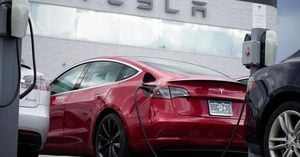It’s a refrain that echoes through British history: economic woes, public discontent, and a sense that the country is teetering on the brink of something bigger. In the 1970s, James Callaghan, then foreign secretary, famously remarked, “Sometimes when I go to bed, I think that if I were a young man I would emigrate.” At the time, the UK was grappling with double-digit inflation, rising unemployment, and anemic growth—a cocktail that eventually forced Callaghan, as prime minister, to request a bailout from the International Monetary Fund. Fast forward to 2025, and while the specifics have changed, the sense of unease remains stubbornly familiar.
Today’s young Britons are taking Callaghan’s musings to heart. According to a recent poll highlighted by The Spectator, more than a quarter of 18- to 30-year-olds have considered emigrating. The data is more than anecdotal: the number of P85 forms—used by taxpayers wishing to go abroad—has more than doubled between 2022 and 2025. The motivations are clear enough: cost-of-living pressures, stagnant wages, and a pervasive feeling of national decline. For many, the dream of a brighter future seems increasingly out of reach at home.
Behind these personal decisions are grim fiscal realities. On August 7, 2025, the National Institute of Economic and Social Research reported a staggering £50 billion shortfall in the UK’s public finances ahead of the autumn Budget. That figure is more than double the deficit Labour accused the Conservatives of leaving behind. Higher-than-expected public borrowing and sluggish economic growth mean tax increases are almost certainly on the horizon. Chancellor Rachel Reeves, who after her last Budget in October 2024 promised “no further tax rises this parliament” following a £40 billion hike, now faces the unenviable prospect of a U-turn. Whether she’ll break manifesto pledges on income tax, national insurance, or VAT remains to be seen, but speculation is already swirling about another inheritance tax raid, especially after last year’s squeeze on farmers.
But Reeves’s predicament is not just about numbers on a spreadsheet. According to The Spectator, her government’s choices last autumn, coupled with an inability to convince backbenchers to cut spending, have left her boxed in. The consequences are stark: 164,000 jobs were lost during Labour’s first year in office—a drop in employment attributed to the Chancellor’s increase in employers’ national insurance. Borrowing figures for June 2025 were the second-highest on record, with the Office for National Statistics blaming the rising cost of public services and ballooning national debt. The UK’s tax burden is at a postwar high, and the national debt is nearing 100 percent of GDP. Perhaps most alarmingly, spending on debt interest now exceeds the entire defense budget.
Amid these domestic troubles, the government admitted this August that the Chagos deal—an international agreement—will cost taxpayers an additional £35 billion, deepening what some have dubbed a fiscal black hole. If market confidence wavers, some commentators warn, Britain could face a crisis reminiscent of the 1970s. “Labour MPs may not be interested in austerity, but austerity is interested in them,” quipped The Spectator, drawing a sharp parallel with past governments forced to make painful cuts.
Yet it’s not as if the opposition parties are offering a radically different path. Conservative profligacy during the pandemic, combined with promises like Rishi Sunak’s pledge to take millions of pensioners out of tax, have also contributed to the current predicament. Reform UK, led by Nigel Farage, has made more than £50 billion in spending commitments—most notably a plan to nationalize half the water industry—that critics say lack credible funding. Both major parties, it seems, are caught between their reluctance to upset voters and the hard fiscal limits of the present moment.
North of the border, Scotland’s fiscal situation is even more precarious. According to Government Expenditure and Revenue Scotland (GERS) figures published just last week, Scotland’s fiscal deficit widened to 11.6 percent of GDP in the 2024-2025 financial year—more than double the UK’s overall deficit. Excluding North Sea oil and gas revenues, the gap balloons to 14.3 percent. Shona Robison, Scotland’s Finance Secretary, has argued that independence would allow Scotland to pursue productivity-enhancing policies like increased immigration and lower corporation tax, but critics, as reported by The Telegraph, are skeptical. The reality, they argue, is that an independent Scotland would face revenues that fall far short of expenditures, making it nearly impossible to borrow on international markets—even if the rest of the UK generously forgave Scotland’s share of the national debt, an unlikely scenario.
The numbers tell a sobering story: Scotland spends about £2,700 more per head each year than the rest of the UK, yet collects roughly the same amount in tax per individual. Total public spending in Scotland last year reached 52 percent of GDP—on par with Scandinavian countries—but without the Nordic-style welfare and services to match. NHS waiting lists are longer, social services are widely criticized, life expectancy is lower, and educational standards have slipped. In Edinburgh, one in four families now sends their children to privately funded independent schools, far above the UK average. That choice is getting costlier, too, with the recent introduction of VAT on school fees.
Energy policy has added another layer of complexity. Westminster’s decision to ban new North Sea oil and gas licenses has hit Scotland particularly hard, threatening high-paying jobs and reducing income tax receipts. The Scottish Government has shifted to a more nuanced stance, assessing new licenses on a case-by-case basis, but the overarching ban remains a major drag on the region’s finances. Critics argue that a smarter approach would have allowed both oil and renewables to coexist, maximizing jobs and revenues, but political realities have gotten in the way.
The SNP and Scottish Labour’s welfare-based economic model, critics say, would quickly become unaffordable in an independent Scotland. Years of austerity would likely follow, as the new nation struggled to bring spending in line with revenues. “The welfare-based economic model that is today’s Scotland would quickly be rendered unaffordable,” The Telegraph noted, suggesting that the shock therapy required might eventually yield a stronger, more self-reliant economy—but at a cost few Scots would willingly choose.
Despite these challenges, the cause of Scottish independence remains alive, buoyed in part by political fragmentation among unionist parties. Reform UK’s rise threatens to split the anti-independence vote, potentially giving the SNP a boost in next year’s Holyrood elections. Political paralysis, it seems, is not unique to Westminster.
Across the UK, the central dilemma is the same: rising taxation, excessive spending, and declining public services. Whether in Westminster or Holyrood, governments are struggling to confront harsh fiscal realities, and voters are left to wonder if anyone has the vision—or the will—to chart a new course. As Kemi Badenoch’s supporters tout her as a second Margaret Thatcher or even Britain’s answer to Argentina’s Javier Milei, the question lingers: must the UK endure the same hardships to restore solvency? For now, many young people are voting with their feet, and the lights, as Callaghan once feared, are flickering.



